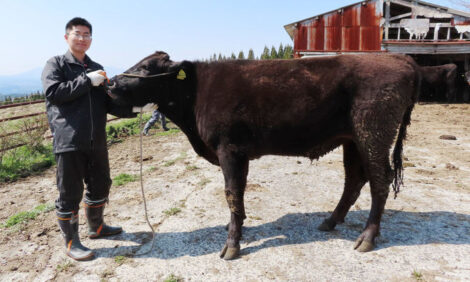



Preventing Chronic Mastitis Infections
Instead of focusing on cows with very high cell counts, should farmers focus more on cows with moderately high cell counts in a bid to prevent the infection worsening, asked Andrew Biggs, from The Vale Veterinary Group in Devon, South England at a recent Pfizer press briefing. Charlotte Johnston, TheCattleSite junior editor reports.
Somatic cell counts (SCC) and mastitis are a major concern to dairy farmers. What bulk milk cell count is acceptable, asked Mr Biggs. Perhaps 100-150,000 cells/ ml?
Cell counts constantly vary, which is due to a combination of absolute numbers and cell types.
Factors that influence cell counts include infection status and mastitis pathogens, stage of lactation, seasonal variations, milking frequency and interval, milking routine and stress.
However, Mr Biggs says that the most significant changes are seen in response to an infection.
Measuring SCC
There are effectively two ways to measure SCC. Either through a bulk milk cell count or an individual cow cell count.
Mr Biggs warns that bulk milk cell counts aren't always the best indication of incidence of high SCC within a herd, as a herd with a low bulk milk SCC could have a very high clinical mastitis rate.
A bulk milk SCC will also not measure prevalence in a herd.
He suggests that producers could compare bulk milk SCC (cows contributing to the milk sold of the farm) with the calculated milk recording bulk milk SCC (all cows in milk). However individual cell counts per cow (a combination off all four quarters) is commonly used.
As a threshold, 200,000 cells/ ml is widely accepted, with 75 per cent sensitivity and 75 per cent specificity. This means that 75 per cent of cows with an infection have a SCC of greater than 200,000 cells/ ml, and 75 per cent of uninfected cows have a SCC less than 200,000 cells/ml.
Lowering the threshold will improve herd sensitivity when measuring SCC, as there is more certainty that cows under the threshold are uninfected. This Mr Biggs says this may be used for younger cows or herds that work from bulk somatic cell counts.
A lower threshold could also be useful when using a selective dry cow therapy protocol - as there is more chance that all infected cows are treated in the dry period with an antibiotic dry cow therapy.
The risk with this is that uninfected cows will be treated, which is arguably uneconomical and expensive.
On the contrary, higher thresholds will mean that it is more certain that cows above the threshold are infected. This eliminates the chances of wasting money sampling or treating cows which may not be infected. However the risk is that some infected cows might be missed.
When measuring cell counts, Mr Biggs says there are four types of cows with a cell count over 200,000 cells/ml.
Those with new infections, first infections, repeat infections and chronic infections.
* "Ignore mediocre cell counts at your peril, warns Mr Biggs." |
Chronic
Through analysing milk recording data between December 2006 and January 2007, it appears that 20 per cent of chronic cases started the current lactation with a high SCC and maintained a high SCC throughout the lactation. Mr Biggs suggests that these cases were likely cows who had maintained an infection from the previous lactation, throughout the dry period and into the current lactation, or that they had picked up a new infection during the dry period.
80 per cent of chronic cases began the current lactation with a low SCC, suggesting that the infection was acquired during the current lactation.
Mr Biggs says that this data proves that the majority of chronic cases occur during lactation.
Of the cows in this data set, 70 per cent of cows began their infected lactation with a SCC of less than 500,000 cell/ml, and 59 per cent continued to have a cell count lower than 500,000 cells/ml.
Mr Biggs says that whilst producers are intent on controlling higher cell counts, most long term somatic cell count problems begin and persist below 500,000 cells/ml, which is backed up by the data above.
Surely, he asks, it is on these cows where we should be focusing all our efforts?
He says that modern technology presents huge opportunities to monitor somatic cell counts, and with this all new infection rates, recovery rates and dry period infection rates should also be monitored.
He also suggests that persisting chronic cases are culled and that efforts are concentrated on treating cows that are curable. The cows that may currently have mediocre cell counts may be tomorrows chronics - ignore them at your peril, warns Mr Biggs.
Concentrating on these cows should involve setting up an individual cow action list. Cows on this list should include those with new/ first infections and cows that have calved with a SCC greater than 200,000 cells/ml - these have likely acquired an infection in the dry period.
Other cows on the action list include non-recovered recent infections, cows that have had recent new/ first infections, some repeat infections and some early chronic infections.
Intervention such as sampling and treating these cows is vital for their survival in the herd.
What influences the decision to treat?
Mr Biggs advises looking at routine monthly SCC records, to see which cows may need sampled, treated, dried off early or culled.
The herd
Factors that should be taken into account include:
- the economics and dynamics
- bulk milk and SCC
- an increased or increasing new infection rate
- dry period performance
What is the chance of curing the individual cow, is a question which Mr Biggs says that all farmers should be asking before treatment. When asking this, previous lactation cell counts and the rate of clinical mastitis cases for that individual must be considered.
Regardless of the above, Mr Biggs says that changes to management will also affect mastitis rates on farm, including milking routine and practice, housing ventilation and hygiene. Treatment is only part of the story, he said.
Concluding Mr Biggs said that SCC data is widely available and should be used to aid farmers and vets. Action lists should be used to help treat individual cows, and prevent them from becoming chronic cases.


